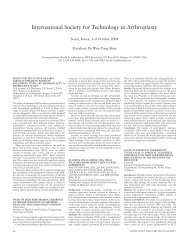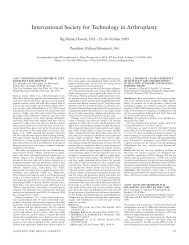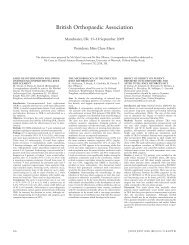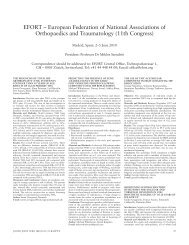Procs III 2011.indb - Journal of Bone & Joint Surgery, British Volume ...
Procs III 2011.indb - Journal of Bone & Joint Surgery, British Volume ...
Procs III 2011.indb - Journal of Bone & Joint Surgery, British Volume ...
You also want an ePaper? Increase the reach of your titles
YUMPU automatically turns print PDFs into web optimized ePapers that Google loves.
362 HELLENIC ASSOCIATION OF ORTHOPAEDIC SURGERY AND TRAUMATOLOGY<br />
anterogradely labelled with MiniRuby, a 10 kD biotinylated<br />
dextran amine.<br />
After 4 days the co-cultures were propagated, and<br />
axonal sprouting occurred. The group <strong>of</strong> co-cultures<br />
treated with NT-3 showed an improved cortical cytoarchitecture,<br />
and sprouting axons were more frequently<br />
observed. In NT-3-treated co-cultures where spinal cord<br />
gray matter was directly opposed to cortical slices sprouting<br />
axons entered the adjacent spinal cord tissue. This<br />
phenomenon was not observed if spinal white matter was<br />
opposed to the cortical slices, or if NT-3 was absent.<br />
Our data suggest that the absence <strong>of</strong> repellent factors<br />
such as white matter and the presence <strong>of</strong> neurotrophic<br />
factors promote axonal sprouting. Co-cultures<br />
<strong>of</strong> motorcortex and spinal cord slices combined with<br />
anterograde axonal labelling could provide a valuable<br />
in vitro model for the simplifi ed screening <strong>of</strong> factors<br />
infl uencing corticospinal tract regeneration<br />
012 THE ROLE OF TSF (TAYLOR SPATIAL<br />
FRAME) IN TREATING TRAUMA AND BONE<br />
DEFORMITIES IN CHILDREN<br />
H. Tsibidakis, V. I. Sakellariou, V.<br />
Tsouparopoulos, G. Mazis, K. Staratzis, A.<br />
Kanellopoulos<br />
1st Orthopaedic Department, University <strong>of</strong><br />
Athens, ATTIKON University General Hospital,<br />
Greece<br />
To study the use <strong>of</strong> TSF system in treating trauma and<br />
bone deformities in children. To determine the diffi culties<br />
<strong>of</strong> this process and the risk factors that lead to complications.<br />
From January 2004, in 61 children (37 male and 24<br />
female), 67 extremities, with a mean age 8.9 years children<br />
a TSF external fi xator was applied for the treatment<br />
<strong>of</strong> trauma or bone deformities. 21 children were operated<br />
for angular deformity, 19 for bone lengthening, 10 for<br />
rotational deformity, 6 for combined angular deformity<br />
and lengthening and 11 for pseudoarthrosis. Intra and<br />
postoperative diffi culties were classifi ed using the Palay<br />
method in problems, obstacles and complications.<br />
The rate <strong>of</strong> diffi culties was 22.2 %. Problems were<br />
presented in 5.9% (4/67) consisting <strong>of</strong> 2 non-axial<br />
deformities, 1 pin fracture and 1 subluxation <strong>of</strong> the<br />
knee. Obstacles were presented in 10.4% (9/67) including<br />
3 cases with delayed bone healing that needed infusion<br />
DBM, 1 peroneal nerve palsy due to hematoma<br />
formation treated with decompression <strong>of</strong> the region, 1<br />
early bone fusion that needed re-operation and 2 cases<br />
<strong>of</strong> percutaneous achilles lengthening. Complications<br />
presented in 5.9% <strong>of</strong> (4/67) the cases including 1 fracture,<br />
1 pseudoarthrosis, 1 peroneal nerve palsy and 1<br />
limitation <strong>of</strong> range <strong>of</strong> motion in the knee (0-45 0).<br />
The problems, obstacles and complications that presented<br />
during treatment infl uenced the fi nal therapeutic<br />
objective. Initial deformity, preoperative planning and<br />
surgeon’s experience are associated with reducing the<br />
rate <strong>of</strong> all diffi culties<br />
013 BONE MORPHOGENETIC PROTEINS<br />
(BMPS) EXPRESSION IN THE FEMORAL<br />
HEADS OF PATIENTS WITH AVASCULAR<br />
NECROSIS<br />
1 S. Samara; 2 Z. Dailiana; 2,3 K.N. Malizos; 2 S.<br />
Varitimidis; 1 C. Chassanidis; 4 T. Koromila; 4 P.<br />
Kollia<br />
1 Laboratory <strong>of</strong> Medical Genetics and<br />
Cytogenetics, University <strong>of</strong> Thessalia, Larissa;<br />
2 Department <strong>of</strong> Orthopaedic <strong>Surgery</strong>, University<br />
<strong>of</strong> Thessalia, Larissa; 3 Institute <strong>of</strong> Biomedical<br />
Research and Technology, Larissa; 4 Laboratory <strong>of</strong><br />
Human Genetics, School <strong>of</strong> Biology, University <strong>of</strong><br />
Athens, Athens<br />
Avascular necrosis (AVN) is a disorder leading to femoral<br />
head (FH) destruction, while BMPs are known for<br />
their osteogenic ability. In this study we analyzed BMP-<br />
2, BMP-4, BMP-6 and BMP-7 expression at the RNA<br />
and protein level in the normal and necrotic sites <strong>of</strong><br />
the FHs.<br />
Quantitative RT-PCR for BMP-2,-4,-6,-7 genes was<br />
performed in samples from the normal and necrotic sites<br />
<strong>of</strong> 52 FHs with AVN. Protein levels <strong>of</strong> BMP-2,-4,-6 were<br />
estimated by Western Blot analysis. Statistical analysis<br />
was performed using the t-test (p








